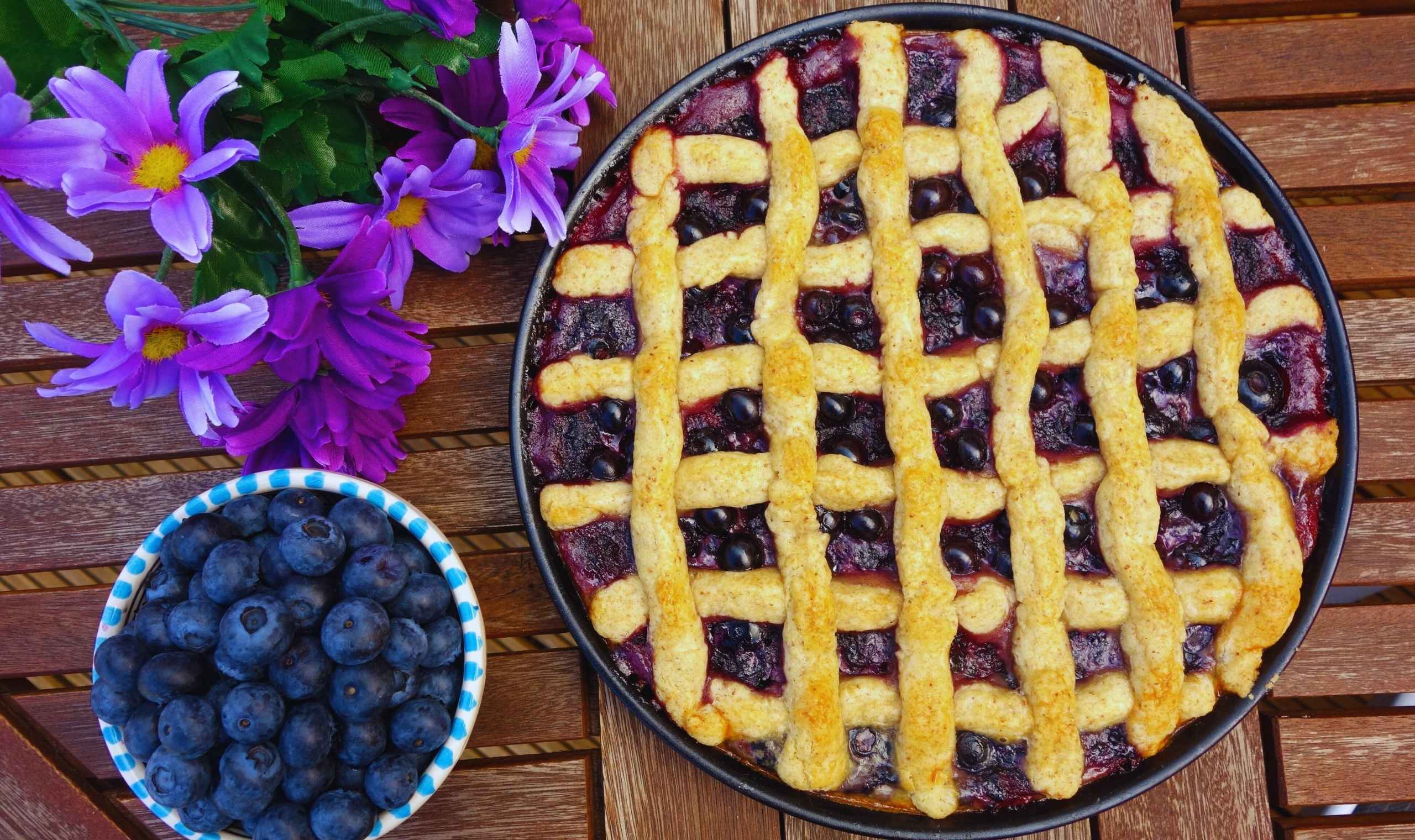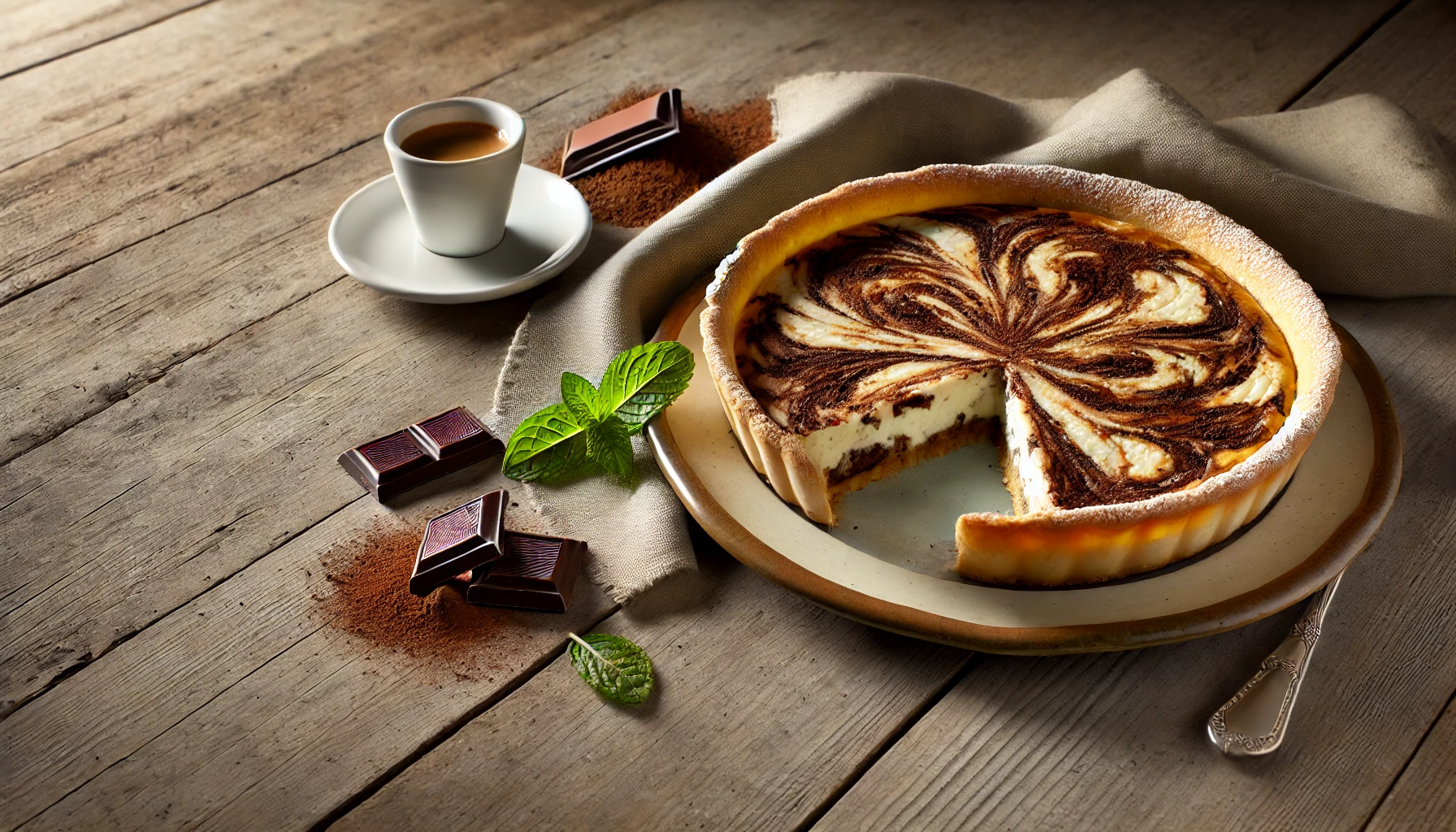Sweden’s Blåbärspaj: A Delicious Journey Through Blueberry Pie
The Origin of Blåbärspaj
The delightful blåbärspaj, or Swedish blueberry pie, holds a significant place in Sweden’s culinary history, deeply rooted in the country’s traditions and cultural practices. Blueberries are native to the Scandinavian region and have flourished in the vast forests and woodlands of Sweden for centuries. This natural abundance has made blueberries a staple foraged fruit in Swedish households, contributing to the development of numerous recipes that celebrate their rich flavor.
Historically, blueberries were not only a vital food source but also an essential element of Swedish sustenance, particularly during the summer months when these berries reached their peak ripeness. The local foraging of blueberries has been a tradition passed down through generations, reflecting the close relationship that Swedes have with their natural environment. Families often gather to pick blueberries, turning this activity into a cherished communal experience, which subsequently paves the way for making various dishes, including the beloved blåbärspaj.
As time progressed, the evolution of blåbärspaj mirrored changes in Swedish cooking techniques and preferences. The pie itself has transformed from a simple home-baked dessert into a widely appreciated delicacy, commonly served at gatherings and celebrations. Seasonal variations include additional ingredients such as spices and lemon zest, enhancing the dish’s flavor profile while retaining the essential components of the classic blueberry pie. Today, blåbärspaj is enjoyed not only in Sweden but has also gained popularity in other cultures, showcasing the cherished flavor of Swedish blueberries on a global scale. This evolution reflects the pie’s enduring relevance in Swedish cuisine, signifying both a connection to cultural heritage and a testament to the resourcefulness of Swedish home cooking.
A Brief History of Blueberries in Sweden
Blueberries, known in Sweden as “blåbär,” have a long-standing presence in the country’s natural landscape and culinary traditions. These small, flavorful fruits have been utilized by Swedes for centuries, serving not only as a readily available food source but also as a vital component of the national diet. Historical records suggest that wild blueberries were consumed by indigenous populations long before the establishment of modern culinary customs.
Traditionally, blueberries were foraged from the abundant forests that cover much of Sweden, particularly during the late summer months when the berries were ripe for picking. This seasonal harvesting has fostered a deep-rooted connection between Swedes and their forests, emphasizing the importance of local and sustainable food sources. Families would often spend weekends foraging in the wild, gathering blueberries to use in various dishes, including beloved desserts like blåbärspaj.
As blueberry cultivation began to take form, particularly in the mid-20th century, Swedish bakeries and households incorporated these berries into their culinary repertoire increasingly. The iconic Swedish blueberry pie, or blåbärspaj, emerged as a favorite dessert, cherished for its sweet, tangy flavor and rustic charm. The pie became synonymous with Swedish culture, often served at family gatherings, special occasions, and holiday celebrations.
The versatility of blueberries extends beyond just desserts; they play a significant role in jams, sauces, and beverages as well, showcasing their ability to enhance a variety of dishes. Today, blåbärspaj remains a staple in Swedish cuisine, representing both a nostalgic connection to the past and a celebration of the rich produce available in Sweden’s forests. The cultural significance of blueberries in Sweden is not only evident in their culinary applications but also in the way these fruits are cherished by generations of Swedes.
The Art of Making Blåbärspaj
Creating the perfect blåbärspaj, or Swedish blueberry pie, entails a delightful blend of simple yet high-quality ingredients, ensuring that the fresh blueberries shine through. To start, gather the essential components which include approximately 2 cups of ripe blueberries, ¾ cup of granulated sugar, 2 tablespoons of cornstarch to thicken the filling, 1 tablespoon of lemon juice for a hint of acidity, and a pinch of salt. For the crust, use 1 ½ cups of all-purpose flour, ½ cup of unsalted butter, softened, and about ¼ cup of ice-cold water. These proportions yield a delicious balance between the crust and filling, essential for an exquisite blueberry pie.
The first step in your blåbärspaj preparation is to create the crust. Begin by mixing the flour and salt in a bowl. Cut in the butter with a pastry cutter until the mixture resembles coarse crumbs. Gradually add ice-cold water until the dough comes together. Once formed, wrap the dough in plastic wrap and refrigerate for at least 30 minutes. This resting period allows the gluten to relax, making the crust flaky.
Next, preheat your oven to 425°F (220°C). While the oven warms, combine the blueberries with sugar, cornstarch, lemon juice, and salt in another bowl, stirring gently to avoid damaging the berries. Roll out the chilled dough on a floured surface, and fit it into a pie pan. Pour the blueberry mixture into the crust, then cover with additional rolled-out dough, creating a lattice or full top as desired. For variations, consider adding a dash of cinnamon or nutmeg to the filling for an aromatic twist, or explore using a graham cracker crust for added texture. Bake for about 35-40 minutes until the crust is golden brown and the blueberries are bubbling.
Once baked, allow the blåbärspaj to cool before serving. This classic Swedish dessert pairs beautifully with vanilla ice cream or whipped cream, making it a delightful treat for any occasion. The blend of fresh blueberries and a suitably textured crust creates a harmonious flavor profile, hence demonstrating the craft of making this beloved blueberry pie.
Swedish Jokes and Folklore Around Blueberries
In Sweden, blueberries are more than just a favored ingredient in the delicious blåbärspaj; they are a vital part of the cultural fabric, often invoked in light-hearted tales and jests. One popular Swedish joke goes: “Why do blueberries always look so cool? Because they hang out in their bluebärspaj jackets!” This type of humor reflects a cherished cultural sentiment where food is not just sustenance but a source of joy and laughter among friends and family.
Folklore surrounding blueberries often conveys the importance of nature and seasonal traditions. Many Swedes tell tales of the mythical woodland creatures that supposedly guard the blueberry patches, playfully warning children to be respectful while foraging. A traditional saying suggests, “A thief may snatch the last blueberry, but only a true friend shares the first pie.” This highlights the significance of community and gatherings, where the sharing of swedish blueberry pie fosters connections and warmth.
Moreover, the act of blueberry picking is often accompanied by stories of humorous mishaps. One such tale involves a father who, while attempting to impress his children with a bountiful harvest, accidentally fell into a bush, resulting in not just laughter, but a memorable family event leading up to a sweet blåbärspaj. Such anecdotes underline the playful side of preparing and enjoying this delightful dessert, bridging generations through shared experiences.
Through jokes and engaging stories, the celebration of blueberries and their iconic representation in Swedish blueberry pie reinforces the light-heartedness of Swedish culture. These tales serve both as entertainment and a reminder of the joy found in simple pleasures, deep-rooted connections, and the cherished custom of coming together over a well-made dessert.
Regional Variations of Blåbärspaj
Blåbärspaj, or blueberry pie, is a beloved dessert in Sweden, with various regional adaptations that highlight the diversity of Swedish culinary traditions. Across the country, local ingredients and customs significantly influence the preparation and flavor profiles of this celebrated dessert. For instance, in the coastal regions of Sweden, where the climate allows for an abundance of wild blueberries, bakers often incorporate these fresher, tangier berries into their blåbärspaj, resulting in a pie that is delightfully vibrant and aromatic.
In contrast, the inland areas may utilize cultivated blueberries, which tend to be sweeter and larger in size. These blueberries lend a different texture and taste to the pie, creating a comforting dessert that suits the traditional fika, or coffee break, that Swedes cherish. Furthermore, many regions have their own twists on the crust; some might employ a buttery shortcrust, while others favor a flaky, puff pastry that adds an extra layer of texture to the dish.
There are also specific serving traditions across the Swedish landscape. In northern Sweden, for instance, blåbärspaj is often served warm with a generous dollop of vanilla sauce, while in the south, it may be accompanied by a scoop of rich vanilla ice cream. These regional variations not only showcase different culinary preferences but also reflect the local harvest seasons and the influence of cultural practices.
Moreover, certain areas often enhance their blueberry pie with unique ingredients. In some parts of the country, a hint of cinnamon is incorporated into the filling, providing a warm and inviting spice that complements the blueberries beautifully. Other bakers might choose to mix in a splash of Swedish schnapps, adding complexity to the flavor profile. Overall, the exploration of blåbärspaj across Sweden reveals a rich tapestry of tastes and traditions that is worth savoring.
Serving Suggestions: Pairing Blåbärspaj
The delightful taste of blåbärspaj, or Swedish blueberry pie, can be elevated through careful pairing with various accompaniments. When serving this beloved dessert, the choice of beverages can significantly enhance the dining experience. Traditional Swedish drinks, such as lingonberry juice or a cup of strong coffee, are excellent options. These options offer a contrasting tartness or robust flavor that complement the pie’s sweetness perfectly.
For those seeking a modern twist, consider serving blåbärspaj alongside a refreshing glass of lemonade or even a fruity spritzer made with sparkling water and fresh blueberries. The carbonation can provide a light and zesty counterpart, balancing the flavors of the pie beautifully. Furthermore, a scoop of vanilla ice cream or a dollop of whipped cream adds a creamy richness that makes each bite of blueberry pie even more indulgent. Alternatively, a drizzle of custard sauce can offer an elegant touch, enriching the overall flavor profile.
Garnishing the blåbärspaj itself can also enhance its presentation, making it suitable for both everyday indulgences and special occasions. Consider sprinkling a dusting of powdered sugar over the top or adding a handful of fresh blueberries as a vibrant garnish. A few mint leaves can also provide a touch of color and freshness, bringing an appealing visual element to your dessert table.
Lastly, presenting your blueberry pie in a delicate pie dish or alongside themed tableware can create a memorable experience during celebrations, while opting for a rustic serving style aligns perfectly with casual family gatherings. Whatever the occasion, the right pairings and presentations can truly prepare blåbärspaj at its finest.
Where to Find the Best Blåbärspaj
Sweden offers a delightful array of places to find authentic blåbärspaj, with each establishment boasting its unique twist on this beloved dessert. For those seeking the perfect slice of blueberry pie, starting your journey in Sweden’s capital, Stockholm, is highly recommended. Here, you can visit the well-known bakery, Vete-Katten, an elegant cafe that has been serving traditional Swedish pastries since the 1920s, including their renowned blueberry pie.
Traveling to Gothenburg, you will discover Café Husaren, famous for its gigantic cinnamon buns but equally noteworthy for its delicious blåbärspaj. This charming cafe is located in the Haga district and makes for an excellent stop to enjoy a piece of blueberry pie complemented by a cup of coffee. Additionally, the city’s vibrant food scene is home to several local markets where you can indulge in fresh Swedish blueberry pie during the summer months when blueberries are in season.
If you venture to the countryside, various small bakeries like Bageri Möllan in Skåne offer authentic, homemade versions of blueberry pie. These local establishments often have their own organic blueberry fields, guaranteeing the freshest ingredients. It is advisable to visit these bakeries in the late morning or early afternoon when the pies are freshly baked, providing the best experience.
Finally, for a travel route that encompasses the charm and beauty of Sweden while sampling delectable blåbärspaj, consider a visit to Lofsdalen in Hälsingland, where you can find quaint cafes that serve traditional dishes made from locally sourced blueberries. Using any mapping tool, you can easily locate these spots and plan a delightful journey dedicated to tasting the finest blueberry pie. By exploring these recommendations, you will certainly enhance your experience with Sweden’s beloved blåbärspaj.
Health Benefits of Blueberries
Blueberries, the primary ingredient in the beloved Swedish dessert known as blåbärspaj, are not only delicious but also packed with numerous health benefits. These small berries are rich in vitamins and nutrients, making them an excellent choice for those looking to incorporate healthier options into their diets. One of the most notable aspects of blueberries is their high antioxidant content. Antioxidants play a vital role in protecting the body from oxidative stress and reducing the risk of chronic diseases.
Specifically, blueberries are an excellent source of vitamin C and vitamin K. Vitamin C is essential for maintaining a healthy immune system, while vitamin K is crucial for bone health and proper blood clotting. Additionally, blueberries contain dietary fiber, which aids in digestion and can contribute to weight management, making a slice of blueberry pie a guilt-free indulgence when balanced with a healthy diet.
Studies have also shown that blueberries may help improve heart health by reducing blood pressure and inflammation, thus lowering the risk of cardiovascular diseases. The presence of flavonoids in these berries has been linked to improved brain function, further emphasizing their role as a brain-boosting food.
For those wishing to enjoy the myriad benefits of blueberries beyond the traditional blåbärspaj, there are many ways to incorporate them into daily meals. They can be added to smoothies, incorporated into yogurt, or used as a topping for oatmeal and cereals. Additionally, enjoying them fresh as a snack or in salads can provide a refreshing twist. The versatility of blueberries means that they can easily fit into various culinary practices, making them a delightful addition to any health-conscious diet.
In conclusion, integrating blueberries into your diet can lead to significant health benefits while still allowing you to enjoy delectable desserts like Swedish blueberry pie. Not only does this treat provide a moment of enjoyment, but it also supports your overall health, making it a win-win for culinary enthusiasts.
Your Own Blåbärspaj: A Personal Recipe Corner
The art of preparing blåbärspaj, or Swedish blueberry pie, is not only about following a recipe but also about the personal experiences and traditions that each home cook brings to their creation. We invite you to explore the chance to share your own blåbärspaj recipes and techniques with others in this vibrant community of baking enthusiasts. Cooking can be a personal affair, allowing individuals to incorporate their unique tastes and cultural influences into each dish.
Perhaps you have a family recipe passed down through generations that adds a special twist to traditional blueberry pie. Or maybe you have experimented with various ingredients, creating a distinct version of blåbärspaj that showcases seasonal fruits or unexpected flavors. Sharing your experiences can inspire fellow cooks to explore new variations and adaptations of this iconic dessert. By exchanging recipes, tips, and techniques, we honor the collaborative spirit of cooking and celebrate the joy of creating something delicious together.
As you reflect on your experiences making blueberry pie, consider what ingredients or methods resonate with you the most. Have you discovered a particular type of crust that enhances the flavor profile? Or do you have a favorite topping that complements the sweetness of the blueberries? Your insights could help others who seek to refine their baking skills or simply find joy in the kitchen.
In sharing your thoughts and recipes, you contribute to a larger conversation about food, culture, and community. Everyone has a story to tell and a recipe to share, so let us come together in this personal recipe corner to inspire each other and ignite a passion for creating exquisite and delightful variations of blåbärspaj. We look forward to reading your submissions and celebrating the diverse ways this beloved Swedish blueberry pie can be enjoyed.




Post Comment